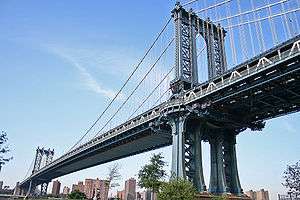Manhattan Bridge
| Manhattan Bridge | |
|---|---|
|
View from Brooklyn | |
| Coordinates | 40°42′26″N 73°59′27″W / 40.707222°N 73.9909°WCoordinates: 40°42′26″N 73°59′27″W / 40.707222°N 73.9909°W |
| Carries | 7 lanes of roadway, 4 tracks of the B D N Q trains of the New York City Subway, pedestrians, and bicycles |
| Crosses | East River |
| Locale | New York City (Manhattan-Brooklyn) |
| Maintained by | New York City Department of Transportation |
| Characteristics | |
| Design | Suspension bridge |
| Total length | 6,855 ft (2,089 m) |
| Width | 120 feet (37 m)[1] |
| Height | 336 ft (102 m) (towers)[1] |
| Longest span | 1,480 feet (451 m)[2] |
| Clearance below | 135 ft (41.1 m)[1] |
| History | |
| Designer | Leon Solomon Moisseiff[1] |
| Constructed by | Othniel Foster Nichols[1] |
| Construction begin | 1901[1] |
| Construction end | 1912[1] |
| Opened | December 31, 1909[1] |
| Statistics | |
| Daily traffic | 70,341 (2008)[3] |
 | |
The Manhattan Bridge is a suspension bridge that crosses the East River in New York City, connecting Lower Manhattan at Canal Street with Downtown Brooklyn at the Flatbush Avenue Extension. The main span is 1,470 ft (448 m) long, with the suspension cables being 3,224 ft (983 m) long. The bridge's total length is 6,855 ft (2,089 m). This is one of four toll-free bridges spanning the East River; the other three are the Queensboro, Brooklyn, and Williamsburg Bridges.
The bridge opened to traffic on December 31, 1909. It was designed by Leon Moisseiff,[1] and is noted for its innovative design. As the first suspension bridge to employ Josef Melan's deflection theory for the stiffening of its deck, it is considered to be the forerunner of modern suspension bridges and this design served as the model for many of the long-span suspension bridges built in the first half of the twentieth century. The Manhattan Bridge was also the first suspension bridge to utilize a Warren truss in its design.[4]
History and description
The Manhattan Bridge was the last of the three suspension bridges built across the lower East River, following the Brooklyn and Williamsburg bridges. It has four vehicle lanes on the upper level, split between two roadways. The lower level has three lanes, four subway tracks, a walkway and a bikeway. The upper level, originally used for streetcars, has two lanes in each direction, and the lower level is one-way and has three lanes in peak direction. The bridge once carried New York State Route 27 and later was planned to carry Interstate 478.
The original pedestrian walkway on the south side of the bridge was reopened after forty years in June 2001.[5] It was also used by bicycles until late summer 2004, when a dedicated bicycle path was opened on the north side of the bridge, again in 2007 while the bike lane was used for truck access during repairs to the lower motor roadway, and for a third time in 2011, when ongoing construction on the north side of the bridge necessitated narrow shelters, narrowing the path to make it unsafe for cycling. The northern bridge bike path is also noted for poor signage that leads to cyclist and pedestrian conflicts.[6]
To celebrate the bridge's centennial anniversary, a series of events and exhibits were organized by the New York City Bridge Centennial Commission in October 2009. These included a ceremonial parade across the Manhattan Bridge on the morning of October 4 and a fireworks display in the evening.[7] In 2009, the bridge was also designated as a National Historic Civil Engineering Landmark by the American Society of Civil Engineers.[8]
Arch and colonnade
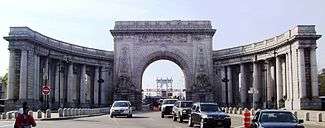


In 1910, a year after the bridge opened, the architectural firm Carrère and Hastings drew up preliminary plans for an elaborate grand entry to the bridge on the Manhattan side, as part of the "City Beautiful" movement. Construction began that year, and plans were finalized in 1912. The arch and colonnade were completed in 1915. The decoration includes pylons which were sculpted by Carl A. Heber and a frieze called "Buffalo Hunt" by Charles Rumsey.[9]
The arch and colonnade were designated a New York City landmark on November 25, 1975. After many years of neglect and several attempts by traffic engineers to remove the structure, the arch and colonnade were repaired and restored in 2000.[9][10]
Subway tracks
Four subway tracks are located on the lower deck of the bridge. On the Manhattan side, the south side tracks, used by N Q trains, connect to Canal Street on the BMT Broadway Line while the north side tracks, used by the B D trains, connect to the Chrystie Street Connection through Grand Street. On the Brooklyn side, the two pairs merge under Flatbush Avenue to a large junction with the BMT Fourth Avenue Line and BMT Brighton Line at DeKalb Avenue. For 18 years, between 1986 and 2004, one or the other set of tracks was closed to repair structural damage.[11]
Trackage history
When the bridge first opened, the tracks did not connect to any others. In 1912, the Manhattan Bridge Three Cent Line and Brooklyn and North River Railroad, two streetcar companies, began operations on those tracks until the BRT (later BMT), which also had two tracks each over the Brooklyn and Williamsburg Bridges, trackage was connected to the bridge in 1915 and the trolleys were moved to the upper level roadways until 1929, when service was discontinued.[12]
The feeder lines for the Brooklyn side of the tracks have not changed since subway service began on the bridge. It has always been fed by tracks from the BMT Fourth Avenue Line and the BMT Brighton Line; however, the junction between the lines was reconstructed in 1956, and Myrtle Avenue subway station, just near the foot of the bridge, was closed.[13] On the Manhattan side, however, the two north tracks originally connected to the BMT Broadway Line (where the south tracks now connect) while the two south tracks curved south to join the BMT Nassau Street Line towards Chambers Street station. This connection has been severed and the tracks are now used for storage.
On November 26, 1931, a connection south of Chambers Street to the Montague Street Tunnel opened, adding two stations (Broad and Fulton Streets) and rerouted train service on the bridge's south side. Service on that side became relatively low afterward as the only trains that normally crossed it were The Bankers’ Special, which ran from either the Sea Beach and/or Fourth Avenue Line, crossed the Manhattan Bridge or Montague Street Tunnel into Manhattan, and then returned to Brooklyn via the opposite crossing.
Since the tracks were on the outer part of the bridge, passing trains caused the structure to tilt and sway. The wobble worsened as train cars became longer and heavier. Eventually over years, when one train moved over the bridge one side would be 3 feet lower than the other side, severely damaging the structure. In 1956 at a cost of $30 million, a repair program was begun. Trains still crossed the bridge, but many times one of the tracks had to be closed with both routes single-tracking, further restricting the number and size of the trains crossing.[14]

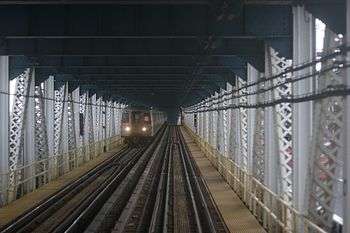
Concurrent with the building of the Chrystie Street Connection (opened November 26, 1967) to connect to the north tracks, the south tracks were rerouted to the BMT Broadway Line connection, and the connecting tracks to the BMT Nassau Street Line were closed and subsequently removed. The connection, and its related projects, opened two new stations (Grand Street and, in July 1968, 57th Street – Sixth Avenue) and added express service on the IND Sixth Avenue Line. The IND B train was extended via this new connection to the BMT West End Line in Brooklyn to replace the T while the D was rerouted from the IND Culver Line to the BMT Brighton Line via the bridge. The N (BMT Sea Beach Line) and Q (BMT Brighton Line) trains now use the south side of the bridge for service to Broadway.[15]
Even after the 1956 repairs, the New York City Department of Transportation failed to maintain the bridge properly, and a major repair program began in 1984. Because of the large scope of these repairs, there was limited train access to the bridge, reducing the number of trains that could cross the span. The north tracks, which had been more heavily used, were closed first. This split B and D service into two sections: trains from the Bronx and upper Manhattan terminated at 34th Street – Herald Square, thus suspending express service on Sixth Avenue, while trains from Brooklyn were rerouted to the BMT Broadway Line express via the south side of the bridge, terminating to the north at 57th Street – Seventh Avenue. The N was rerouted via the Montague Street Tunnel.
The north tracks were reopened and the south tracks were closed simultaneously in December 1988, merging again the B and D services, rerouting the Q to Sixth Avenue, and suspending, and returning express service on the Broadway, and Sixth Avenue Lines, respectively. After an 18-month delay of procurements, the New York City Transit Authority and politicians pressured the DOT to resume N train service on the bridge's south side on September 30, 1990, despite warnings from engineers that the structure was unsafe and major repairs still had to be made.[16][17] On December 27, state inspectors forced south side service to be rerouted via the tunnel again after discovery of corroded support beams and missing steel plates.[16] Following the controversial firing of the city's deputy commissioner for bridges, David Steinberger and his administrative assistant David Bronstein by Transportation Commissioner Lucius Riccio after this closing, the New York City Council's Transportation committee held an inquiry into the decision to restore subway service on the Manhattan Bridge south side (as well as the safety of all New York City bridges) with reluctance from Riccio and Mayor David Dinkins.[17][18][19][20] They found that the Transportation Department and Transit Authority's lack of cooperative inspection were a major contributor for the deteriorating conditions.[21][22][23]
A projection for a reopening date was initially made for 1995.[24] That year, the north side was closed during off-peak hours for six months, rerouting the Q to Broadway and cutting D service from Brooklyn and B service from Manhattan. The south side finally reopened on July 22, 2001, whereby the north side was again closed, returning the Q to Broadway (thus returning express service on the Broadway Line), introducing the new W train (which ran on the West End Line), and cutting B and D service from Brooklyn. The south side was closed on weekends from April to November 2003, rerouting the Q via the Montague Street Tunnel.[25] On February 22, 2004, the north side reopened, and all four tracks were in service simultaneously for the first time in 18 years. B and D trains returned to Brooklyn, but switched southern routes (B to the Brighton Line, and D to the West End Line), the N once again used the bridge for travel, and the W no longer ran in Brooklyn.[26][27]
Between August 2, 2013 and September 14, 2014, weekend R service ran on the south tracks due to Hurricane Sandy-related repairs in the Montague Street Tunnel.
Subway tracks used
Proposed I-478 designation
As part of the construction of the Lower Manhattan Expressway, there were plans to make the Manhattan Bridge I-178, but since this interstate would have led to a crosstown expressway and the existing Brooklyn-Queens Expressway, the FHWA said that the first digit should be even, so the designation I-478 was chosen.[28] However, with the cancellation of I-78 through New York City, the spur neither qualified to be part of the Interstate Highway System nor connected to any existing highways (though ramps directly from I-278 (Brooklyn-Queens Expressway) are accessible on the Brooklyn side).
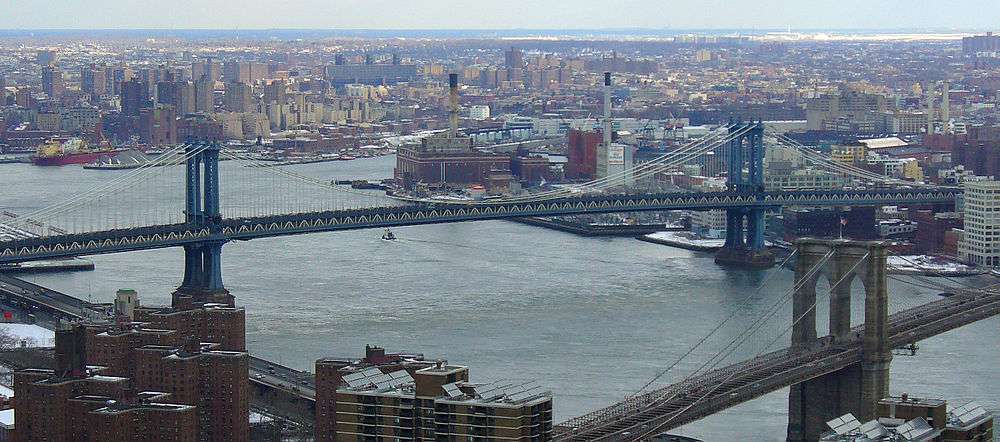
In popular culture

- 1928: The bridge is the subject of American artist Edward Hopper's famous painting Manhattan Bridge Loop.
- 1961 The troubled main character in Something Wild attempts suicide by trying to jump from the bridge to the river below, only to be saved from doing so by a man who then imprisons her in his apartment.
- 1984: The bridge plays a large role in the romantic comedy film The Lonely Guy, in which it is a popular spot for lonely guys to commit suicide, and the meeting place for the Steve Martin and Judith Ivey characters.
- 1984: The bridge is featured prominently in director Sergio Leone's gangster epic Once Upon a Time in America.
- 1994: In The Cowboy Way, the two main cowboy characters chase a B train over the bridge to rescue a friend in grave danger.
- 1995: The villain Two-Face uses the bridge's Brooklyn anchorage for his hideout in the film Batman Forever.
- 1999: In Aftershock: Earthquake in New York, the Manhattan Bridge is one of many NYC landmarks to be destroyed by the earthquake that devastates Manhattan.
- 2005: The bridge is featured prominently in Peter Jackson's remake of King Kong.
- 2006: Construction of the Manhattan Bridge appears as a sub-plot in Jed Rubenfeld's novel The Interpretation of Murder.
- 2007: The film I Am Legend shows the Brooklyn and Manhattan Bridges with their center spans destroyed. A flashback reveals they were hit by missiles to stop the exodus from a quarantined Manhattan. It also appeared in Project Gotham Racing 4 along with the Brooklyn Bridge
- 2008-09: The bridge is featured in the video game Grand Theft Auto IV, in which the bridge is named the "Algonquin Bridge" and it is in Liberty City. The Algonquin Bridge also appears in the GTA games The Lost and Damned, The Ballad of Gay Tony, and Chinatown Wars. However, in the latter game the bridge has four suspension towers instead of two.
- 2009: In the remake of the film The Taking of Pelham 123, the final showdown between Ryder and Walter Garber takes place on the south pedestrian deck of the Manhattan Bridge.
- 2012: The bridge, placed in a fictional Gotham City, is destroyed along with neighboring Williamsburg Bridge, Brooklyn Bridge, and several fictional bridges in the 2012 film The Dark Knight Rises.
Gallery
-

View from the Brooklyn Bridge
-
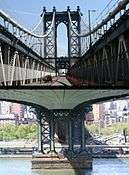
Cross section of the bridge
-

Manhattan-bound lower level
-
One of the pedestrian walkways
-
Manhattan bikeway
See also
- New York City portal
- Bridges portal
References
Notes
- 1 2 3 4 5 6 7 8 9 Manhattan Bridge at Structurae
- ↑ Jackson, Donald C. (1988). Great American Bridges and Dams. Wiley. p. 136. ISBN 0-471-14385-5.
- ↑ "New York City Bridge Traffic Volumes 2008" (PDF). New York City Department of Transportation. March 2010. p. 63. Retrieved 2010-07-10.
- ↑ American Society of Civil Engineers Metropolitan Section (2014). "Manhattan Bridge". Historic Landmarks. New York City: American Society of Civil Engineers Metropolitan Section. Retrieved 2014-06-02.
- ↑ Newman, Andy (June 26, 2001). "Cyclists and Walkers Regain a Bridge". The New York Times. Retrieved 2010-04-24.
- ↑ Robbins, Christopher (June 4, 2014). "Even The DOT Is Confused About Where To Walk On The Manhattan Bridge". Gothamist. Retrieved 2016-01-30.
- ↑ "Manhattan Bridge Centennial Celebration Events and Exhibits". NYC Bridge Centennial Commission. Retrieved 2010-02-21.
- ↑ "Manhattan Bridge". ASCE Metropolitan Section. Retrieved 2010-02-21.
- 1 2 New York City Landmarks Preservation Commission; Postal, Matthew A. (ed. and text); Dolkart, Andrew S. (text). (2009) Guide to New York City Landmarks (4th ed.) New York: John Wiley & Sons. ISBN 978-0-470-28963-1, pp. 45-46
- ↑ White, Norval & Willensky, Elliot (2000). AIA Guide to New York City (4th ed.). New York: Three Rivers Press. ISBN 978-0-8129-3107-5., p.82
- ↑ nycsubway.org—The New York Transit Authority in the 1980s
- ↑ "BMT 4th Avenue Subway". nycsubway.org. Retrieved 2006-12-19.
- ↑ "Dekalb Ave Escalators 1961".
- ↑ "First Aid For An Ailing Bridge." Popular Mechanics, February 1956, pp. 126-130.
- ↑ "www.nycsubway.org". www.nycsubway.org.
- 1 2 Hevesi, Dennis (December 28, 1990). "Hazards Halt Manhattan Bridge Subway Line". The New York Times. Retrieved 2010-03-18.
- 1 2 Sims, Calvin (January 8, 1991). "New York Reopened Bridge Subway Line In Spite of Warnings". The New York Times. Retrieved 2010-03-18.
- ↑ Sims, Calvin (January 11, 1991). "New York Dismisses Official Who Attacked Bridge Cuts". The New York Times. Retrieved 2010-03-18.
- ↑ Sims, Calvin (January 12, 1991). "2d Official In Bridge Unit Is Discharged". The New York Times. Retrieved 2010-05-22.
- ↑ Stanley, Alessandra; Sims, Calvin (January 14, 1991). "Bridge Battle: Clashes and Flurry of Memos". The New York Times. Retrieved 2010-05-22.
- ↑ Lee, Felicia R. (January 30, 1991). "Council Given Data It Sought, Deputy Mayor Says". The New York Times. Retrieved 2010-03-18.
- ↑ Sims, Calvin (January 31, 1991). "Memos Not Released by Dinkins Are Said to Call Bridges Unsafe". The New York Times. Retrieved 2010-03-18.
- ↑ Sims, Calvin (March 1, 1991). "Bridge Troubles Are Linked To a Lack of Coordination". The New York Times. Retrieved 2010-03-18.
- ↑ "Update: Those Weeklong Repairs May Be Done by '95". The New York Times. May 17, 1992. Retrieved 2010-03-18.
- ↑ Manhattan Bridge Service Changes - The New York Times
- ↑ Four-track Service Returns To Manhattan Bridge, MTA Employee Newsletter.
- ↑ "The JoeKorNer Brochures".
- ↑ "3-digit Interstates from I-78". kurumi.com. Retrieved 2006-12-19.
External links
| Wikimedia Commons has media related to Manhattan Bridge. |
- Historic American Engineering Record (HAER) No. NY-127, "Manhattan Bridge"
- Manhattan Bridge at New York City DOT
- Manhattan Bridge at NYCsubway.org
| ||||||||||||||||||||||||||||||||||||||||||||||||||||||||||||||||||||||||||||||||||||||||||||||||||||||||||||||||||||||||||||||
